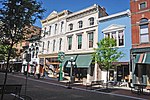Mayo–Underwood School
1929 establishments in Kentucky1964 disestablishments in KentuckyAfrican-American history of KentuckyBuildings and structures demolished in the 1960sDefunct schools in Kentucky ... and 4 more
Demolished buildings and structures in KentuckyHistorically segregated African-American schools in KentuckyPublic high schools in KentuckySchools in Franklin County, Kentucky
The Mayo–Underwood School (1929–1964), a successor to the Clinton Street High School (1882/1884–1928), was a segregated public elementary and high school for African American students in Frankfort, Kentucky, United States. There is a historic plaque at the former site of the Mayo–Underwood School.
Excerpt from the Wikipedia article Mayo–Underwood School (License: CC BY-SA 3.0, Authors).Mayo–Underwood School
Mero Street, Frankfort
Geographical coordinates (GPS) Address Nearby Places Show on map
Geographical coordinates (GPS)
| Latitude | Longitude |
|---|---|
| N 38.202883 ° | E -84.8772 ° |
Address
Mayo-Underwood Building
Mero Street 500
40601 Frankfort
Kentucky, United States
Open on Google Maps








